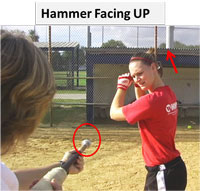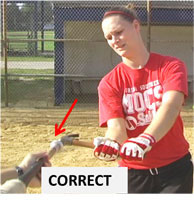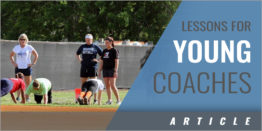|
How a Hammer Can Help By: Cindy Bristow Provided by: Softball Excellence
A long bat, a moving ball, 2 hands - it all gets difficult fast for many hitters. So help crystalize the hand-path concept by using a common, every-day hammer. Of all the hitting drills I know, this is definitely one of the best! Not only is it simple, but it makes sense to hitters and most importantly, they can transfer it to actually hitting a ball with a bat (something that many hitting drills don't do!). Hammer 1:
Let's start with a quick concept review. A hitter's hands start behind her (near her back shoulder) and she's got to move them in front of her toward the pitcher (staying close to her body). The problem comes when a hitter's first motion is to move her hands out toward the plate instead of forward toward the pitcher. Once a hitter has moved her hands toward the plate, she is going to be late to contact, and will end up hitting the side of the ball. While this might sound logical, at least it does to coaches, hitters hit with their hands, so they've got to FEEL and not just HEAR those concepts. And feeling their hands move when holding a 3 foot long stick, gets difficult. That's where the hammer comes in. The picture to the right shows the hitter holding the hammer by the handle, just like she would her bat. Hammer 2:
The head of the hammer is facing UP, or toward the sky. The coach holds the players bat with the knob facing the player - and it's the knob that will represent the ball in this drill. Ask the hitter to SLOWLY swing the hammer just like she would her bat, and come to a slow stop at the knob of the bat you're holding. If she's moving her hands correctly then the hammer head will never go beyond the bat knob (Correct Picture). But, if she's like a lot of hitters she'll have moved her hammer out toward home plate first BEFORE moving forward and will end up having to move the hammer head back toward the bat knob (Incorrect Picture), in order to make square contact. This action of moving the hands OUT toward home plate instead of forward toward the pitcher is called casting, or barring out, and results in a hitter typically being late to contact and pulling a majority of balls foul. Hammer 3:
Once your hitter takes the hammer on the correct path directly to the bat knob, then have her start her swing with the hammer square on the bat knob and then push the bat through your hands (add some slight resistance). This helps hitters practice a "long" forward follow-through instead of wrapping around the ball and simply grazing the ball on their way to the side - resulting in a loss of power and few balls hit fair. For more great Hitting Drills, check out the following: • Hitting Drills Manual (75 great hitting drills for beginning, intermediate and advanced hitters)
|









